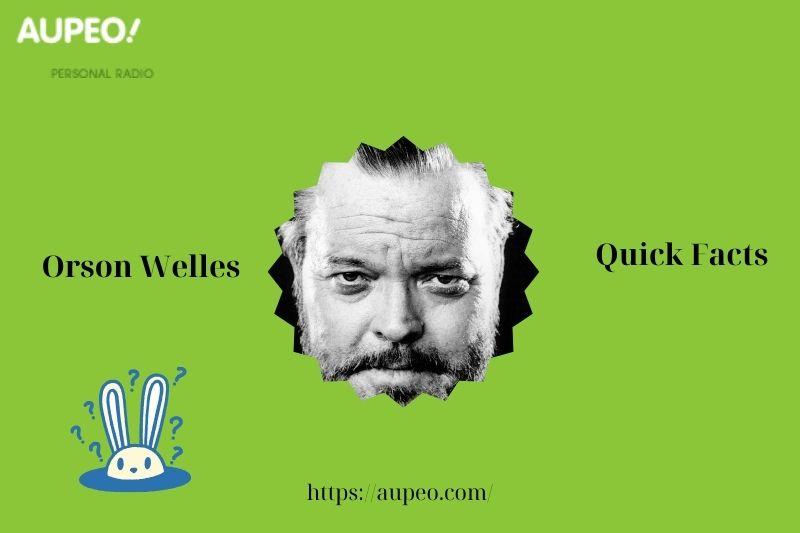
Orson Wells was a legendary filmmaker, an actor and a radio personality whose impact on Hollywood remains inappropriate.
He revolutionized the cinema with Citizen Kane and gained early popularity during the World Radio Transfer War. But beyond his artistic achievements, many are interested in the net value of Orson Welles and how he managed to finance over time.
His financial trip was full of triumph and battles. To ensure a profitable Hollywood deal, later in the face of financial instability in his life, his wealth varied throughout his career.
This article explores its income, sources of wealth, and financial challenges that give the reader its financial heritage.
Orson Welles Fast Facts

| Fact | Detail |
|---|---|
| The real name | George Ornon Welles |
| A popular name | Orson Welles |
| Date of birth | May 6, 1915 |
| Age | 70 (died: October 10, 1985) |
| Birthplace | Kenosha, Wisconsin, USA |
| Nationality | American |
| Ethnicity | Caucasian |
| Education | Todd Seminary for boys |
| Marital status | Married |
| Wife | Paola Moore (M. 1955–1985), Rita Hyworth (M. 1943-1947), Virginia Nicholson (M. 1934-1940) |
| Children | Rebecca Weles, Beattle Wilde, Christopher Weles Federer, Chris Weles Federer |
| Introduction | Oja Kodar (long -term companion) |
| Brothers | 1 older brother (institutionalized) |
| Parents | Richard Head Wales, Bitrizi Ive Wales |
| Height (m) | 1.83 m |
| The sacred is worth | Rated $ 20 million |
| Source of wealth | Film, Radio, Theater, Director, Actor, Writing |
What is the net value of Orson Wales in 2025?

He died in 1985, and the financial impact of Orson Welless continues today. Its sacred value was about $ 20 million at his death (tailored to inflation). At the same time, his property and subsequent film from subsequent publications influenced its long -term financial presence.
Wales was known for his independent cinema and resistance to studio control, which influenced its financial stability. Unlike some of his peers, he often fought with funding, relying on European investors for projects. Compared to directors such as Alfred Hitchcock and Stanley Kubrick, Wales had no less financial success for his unconventional approach.
Related figures in its industry:
- Mercury theater
- Rko radio pictures
- Alfred Hitchcock
- Stanley Kubrick
- Francis Ford Coppola
- Hollywood Film Industry
- Academy Rewards
- American Cinema
- Rita Heavort
- Oja Kodar
Want to know more about the greatest income of the entertainment world? Check Hollywood legends.
Orson Welles wealth, salary and financial review

How did he build his wealth?
Welles’s financial success was from multiple enterprises. His theatrical career began with the Mercury Theater, which recognized his innovative production. His radio career has brought him great popularity, especially WorldThat made him a family name.
However, his Hollywood has come Citizen KaneWhich he wrote, the director, and played. Although it was a critical success, the film was not an immediate financial blow. Its later projects, including Brilliant Ambersons Sister Wicked touchThe challenges of production were faced with the influence of its profit.
What was his main source of income?
Wales had a variety of income streams, including:
- Movie’s win: Citizen Kane” Mrs. From Shangha” Wicked touch
- Theater Performance: Mercury Theater and Broadway Performance
- Radio broadcast: World And other radio shows
- Narration and approval: Remove sound in various projects
He was among the highest paid radio actors in the early career, making about $ 2,000 a week-a significant amount of money in the 1930s. However, his Hollywood profit was significantly different from studio disputes.
Did he face financial battles?
Although Wildes was a well -known film director, he often fought financially. Unlike mainstream directors who have provided the studio’s consistent deals, he often fought for creative control. This has led to:
- Contract disputes with RKO and other studios
- Self -financed movies, to impose personal assets risk
- Reduce Hollywood capabilities in its subsequent years
- Attitude to European Funding Projects
His financial battles have been obvious in recent years when he has received commercial work, including television appearance and sound roles to support himself.
How has his property and finances changed over time?
Welles’s finances saw Rollercoaster’s trip:
- Early Success (1930s in the 1940s): Increase in Radio, Theater and Hollywood.
- Middle Career Failure (1950th-1960s): Lost financial support from studios fought to complete projects.
- Later years (1970-1980): attitude towards small roles, independent cinema and television work.
- Postpartum profits: His films have gained more recognition, which has resumed financial interest.
What happened to his property after his death?
After his death in 1985, the wildlife’s property was divided between family members and a long -time partner Oja Kodar. Her movie rights have become a major discussion The other side of the wind It only came out in 2018.
His legacy remains strong in Hollywood, his films still studied in cinema history courses around the world.
Conclusion
Orson Welles left an inappropriate sign on the film and radio industries, but its financial trip was far away.
His devotion to artistic freedom was often done at a price, but his legacy is invaluable.
Visit GEA – Video Clip.com for a more in-depth financial accident in Hollywood and explore our latest views. Let us know your thoughts in the comments!



